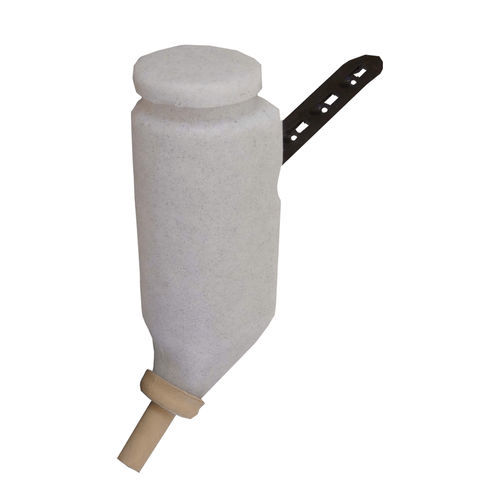

- Products
- Catalogs
- News & Trends
- Exhibitions
Calf nursing bottle 930100
Add to favorites
Compare this product
fo_shop_gate_exact_title
Characteristics
- Animal type
- for calves
Description
The Braden Start Bottle & Nipple features a unique vertical-opening nipple design that encourages early grain feeding. This aids rumen development resulting more nutrient absorption and earlier microbial action in the rumen. Calves show a strong nursing instinct the first three days after birth and the design of the Braden Start Bottle makes it easy for calves to get the hang of eating dry feed through a bottle. Clean dry feed is efficiently dispensed by the exclusive design of the rubber Snap-On nipple and the calf gets virtually all of the feed with very little spillage.
How to use
Starting calves early is key, so, hang the bottle the first day calves are brought to the pen or hutch.
Hang the bottle in the corner of the pen with the nipple approximately 85cm from ground, the calf should reach up slightly.
Pull bottle firmly against the rail with the strap flat to allow the bottle to move. Secure with a nail or screw in the slotted key hole within the strap.
Proper installation should allow the bottle to be jostled so the feed flows freely.
The nipple opening must always be vertical, match the arrows on the nipple to those on the bottle.
Most types of grain will flow through the bottle. Feeds containing corn that has been flattened out larger than the end of the nipple will not work. Feeds with molasses are too sticky and will not flow.
For best results, leave the Braden Bottle with the calves for 6 weeks.
In single calf hutches, one nipple will generally last for 2-3 calves.
In groups of calves, allow one bottle for every 2.5 calves.
Catalogs
No catalogs are available for this product.
See all of Milk Bar NZA‘s catalogsExhibitions
Meet this supplier at the following exhibition(s):


Sommet de l'élevage 2025
7-10 Oct 2025 Clermont-Ferrand (France) Hall Hall 4 - Stand BC44
More information
Related Searches
- Drinker
- Plastic drinker
- Bowl drinker
- Trough drinker
- Multi-access drinker
- Trough
- Hopper feeder
- Single access drinker
- Metal trough
- Wall-mounted drinker
- Multi-access hopper feeder
- Plastic trough
- Multi-access trough
- Plastic hopper feeder
- Cattle trough
- Sheep drinker
- Polyethylene drinker
- Nursing bucket
- Plastic nursing bucket
- Nursing bucket with drinking nipples
*Prices are pre-tax. They exclude delivery charges and customs duties and do not include additional charges for installation or activation options. Prices are indicative only and may vary by country, with changes to the cost of raw materials and exchange rates.




